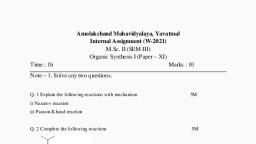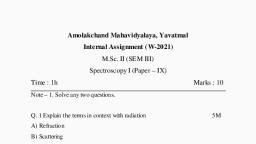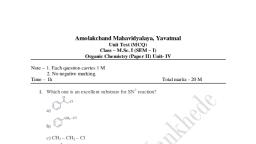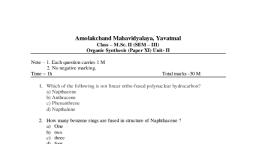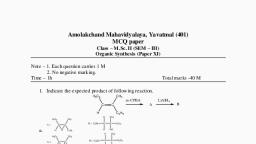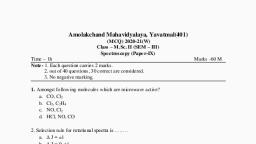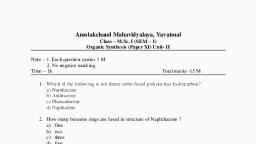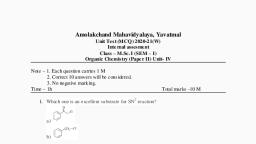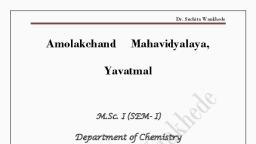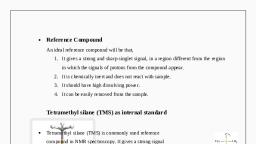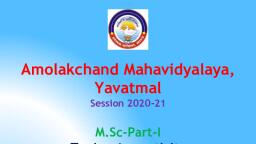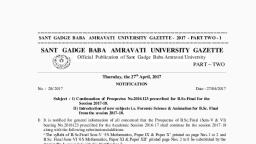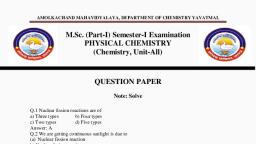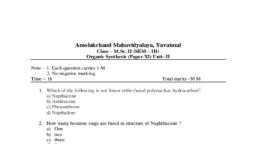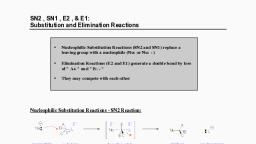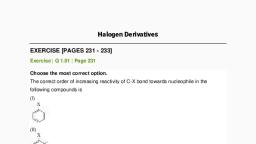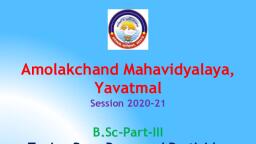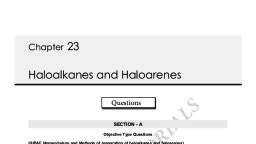Page 4 :
Dr. Suchita B. Wankhede, , Nucleophile, • Species or reagent containing negative charge or neutral Lewis bases are known as nucleopliles., • These are basic and electron rich reagents., • They tend to attack electron deficient center., , Substitution reaction, Reaction in which one group is replaced by other is known as substitution reaction., , Nucleophilic Substitution Reaction, The reaction in which one nucleophile is substituted by other is known as nucleophilic substitution reaction., , Amolakchand Mahavidyalaya, Yavatmal
Page 20 :
Dr. Suchita B. Wankhede, , Nucleophilicity is a measure of how readily an atom donates its electron pair to, other atom., , Basicity is a measure of how readily an atom donates its electron to pair to, other atom., , Amolakchand Mahavidyalaya, Yavatmal
Page 24 :
Dr. Suchita B. Wankhede, , The SN1 reaction requires ionization of covalent bond to form cabocation., It is favored by solvent with high dielectric constant., Transition state in SN1 is more polar and hence it is more stabilized by polar solvent, through solvation., In addition to dielectric constant, the ability to form hydrogen bonding with, X - makes a protic solvent better solvent for SN1 reaction., , Amolakchand Mahavidyalaya, Yavatmal
Page 27 :
Dr. Suchita B. Wankhede, , S – Substitution, N – Nucleophilic, 2 – Bimolecular or second order, , Example, , Alkaline hydrolysis of methyl bromide to give methyl alcohol is an example of SN2, reaction., , Kinetics, , The rate of reaction is depends on the concentration of both the substrate and on, the concentration and nucleophilicity of the attacking reagent. Hence it is second, order or unimolecular reaction., Rate = K[(CH3-Br)(OH-)], Amolakchand Mahavidyalaya, Yavatmal
Page 28 :
Dr. Suchita B. Wankhede, , Mechanism involves only one step., Synchronous attack by the nucleophile from the opposite side of carbon atom of, substrate bearing leaving group takes place., In the transition state nucleophile-carbon bond is partially make while C-X bond, is partially broken., Three groups on carbon in transition state are lie in plane while incoming nucleophile, and leaving group forms partial bond to carbon. Thus in transition state there are five, bonds around carbon atom., , Slow, , Fast, , Amolakchand Mahavidyalaya, Yavatmal
Page 32 :
Dr. Suchita B. Wankhede, , SN2 reactions are, bridgehead carbon atom., , not, , possible, , at, , SN2 reaction mechanism requires backside, attack, of, nucleophile,, inversion, of, configuration and coplanarity of the three, nonreacting groups in the transition state., As all these requirment are prevented at, the bridgehead carbon due to rigid cage like, structures of compounds., , Amolakchand Mahavidyalaya, Yavatmal
Page 33 :
Dr. Suchita B. Wankhede, , As an alkyl group connected to reacting carbon increases rate of, reaction get slower ., Hindered and bulky substrate prevent easy approach of the nucleophile,, making bond formation difficult., The transition state with sterically hindered substrate, is higher in, , energy and forms very slowly., Thus with increase in Steric effect on reactivity of SN2 reaction goes on, , decreasing., , Amolakchand Mahavidyalaya, Yavatmal
Page 39 :
Dr. Suchita B. Wankhede, , Groups that is replaced by incoming group is good, leaving group., Leaving group that provide optimal stability to the, negative charge in transition state aee considered, the best., Weak bases are the best leaving groups., Stronger the conjugate acid of the leaving group,, , better is its leaving ability., , Amolakchand Mahavidyalaya, Yavatmal
Page 44 :
Dr. Suchita B. Wankhede, , Aliphatic nucleophilic substitution reaction at allylic substrates takes place rapidly through, rearrangment known as allylic rearrangment., , Two products are usually formed , the normal, product and a rearranged product., This can be explianed on the basis of formation of, two allyl cation resonance structures., , This mechanism is called as SN1’ mechanism., , If double bond is in conjugation with an aromatic, ring, then it is more stable and predominant at, , equilibrium., Amolakchand Mahavidyalaya, Yavatmal
Page 48 :
Dr. Suchita B. Wankhede, , “The reaction in which , unshared electron pair (lone pair) on atom or group ,, which is at beta position to leaving group , undergo two consecutive SN2, substitutions with inversion of configuration, thus results in net retension of, configuration, is known as Neighbouring group participation.”, In the first step of mechanism, the neighbouring group acts as nucleophile, undergo intramolecular SN2, reaction and leads to leave neighbouring group., This results in formation of a cyclic intermediate., In the second step the external nucleophile undergoes SN2 reaction, on cyclic intermediate to form product, with net result in retension of configuration., Such reaction occurs thousand times faster than comparable intermolecular nucleophilic substitution., , Amolakchand Mahavidyalaya, Yavatmal
Page 49 :
Dr. Suchita B. Wankhede, , This rate enhancement by neighbouring group participation is called anchimetric assistance and such reactions, are called anchimetrically assisted reactions., Such reactions follows first order rate law., Step 2, , Step 1, , Z, , C, , C, , C, -L, , Fast intermolecular, SN2 (inversion), , Z, , Slow intramolecular, SN2 (inversion), , C, , Nu, , L, Z, , C, , C, Nu, , Retention of configuration, , Amolakchand Mahavidyalaya, Yavatmal
Page 50 :
Dr. Suchita B. Wankhede, , Ex. When 2-bromopropionic acid is treated with dilute alkali, it gives lactate anion, with complete retention of configuration., H, O, , H, , C, , CH3, , C, , O, , O, , +, , OH, , H, , C, , -H2O, , Br, , CH3, , C, , O, , Br, , (R)-2-bromopropionic acid, Intramolecular SN2, Inversion, , - Br, , H, , O, , O, , H, , C, O, , C, , CH3, , OH, , H-OH, , O, , C, O, , C, , H, , C, , CH3, , O, , C, , H, CH3, , 2, , OH, , Intermolecular SN, Inversion, , OH, , (R)-Lactic acid, Net result is retension, , Amolakchand Mahavidyalaya, Yavatmal
